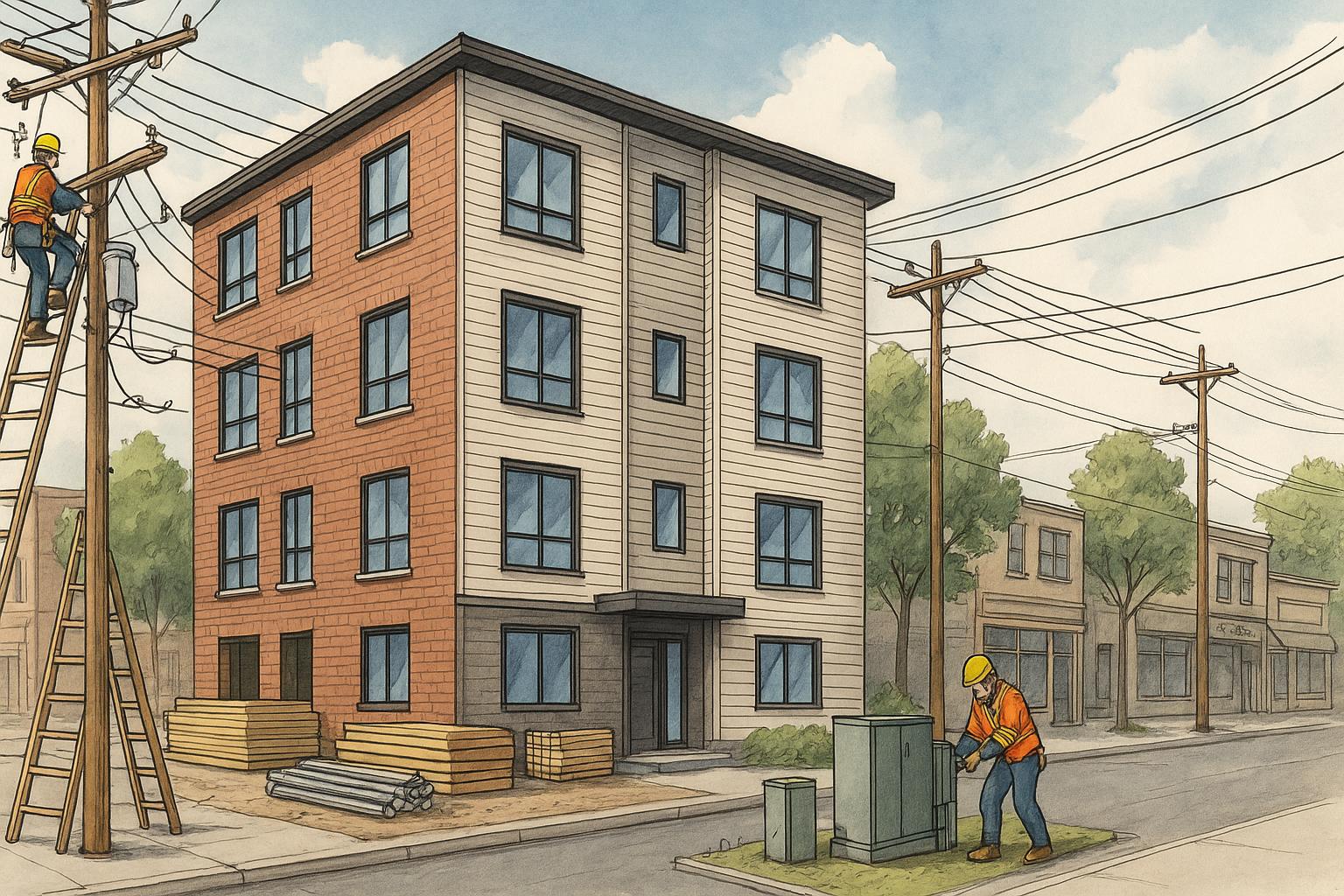If you're planning a multi-unit development in Nova Scotia's CEN-2 zoning area, you'll need to complete specific studies to secure municipal approval. These include:
- Wind studies: To ensure pedestrian comfort and safety by analysing airflow changes.
- Shadow studies: To assess sunlight impacts on neighbouring properties and public spaces.
- Public realm assessments: To evaluate how your project interacts with shared spaces like sidewalks and parks.
These studies are crucial for projects nearing the maximum height (up to 90 m or ~29 storeys) or significantly altering the streetscape. Working with skilled professionals, submitting detailed and accurate documents, and engaging with municipal staff early can help you avoid delays. Proper coordination and communication are key to keeping your project on track.
CEN-2 Zoning Requirements and Study Basics
Understanding the essentials of CEN-2 zoning is key when navigating project approvals and planning requirements.
What CEN-2 Zoning Allows
CEN-2 zoning is designed for high-intensity, mixed-use developments, permitting mid- to high-rise structures up to 90 m tall (roughly 29 storeys) [1]. Projects within this zoning typically combine residential units with ground-floor commercial spaces. However, multi-unit developments here must adhere to specific processes, including obtaining a Development Permit, Site Plan Approval, and meeting Density Bonusing requirements. Larger or more context-sensitive projects may also face additional assessments to address potential community impacts.
While this zoning offers flexibility, the approval process becomes more rigorous for projects that push the limits of height or density, underscoring the importance of certain impact studies.
Why Wind, Shadow, and Public Realm Studies Matter
Municipal planners rely on various assessments to ensure new developments enhance the urban environment while accommodating increased density. Although not every multi-unit project requires wind, shadow, or public realm studies, developments nearing the maximum height or significantly altering the streetscape often trigger these reviews.
- Wind studies analyse how a building influences street-level airflow, ensuring pedestrian comfort and safety.
- Shadow studies evaluate whether neighbouring properties and public spaces receive adequate sunlight, maintaining liveability.
- Public realm assessments focus on how a project integrates with shared spaces, considering elements like sidewalk width, pedestrian flow, and the overall feel of the neighbourhood.
The Halifax Regional Municipality’s planning regulations empower municipal strategies to mandate studies for specific developments or areas [2]. This approach allows municipalities to align assessments with local priorities and urban planning goals.
Which Municipal Departments Review Your Studies
Several municipal departments play a role in reviewing these studies:
- Planning departments ensure projects align with the neighbourhood's character and broader municipal objectives. They review shadow assessments to confirm public spaces maintain adequate sunlight.
- Engineering teams focus on technical reviews, such as wind studies, to safeguard pedestrian safety and prevent disruptions to surrounding infrastructure.
- Development officers act as the central point of contact, coordinating between departments and clarifying study requirements to ensure all necessary information is submitted.
These collaborative reviews aim to balance development ambitions with community well-being, creating spaces that benefit everyone involved.
How to Manage Required Studies: Step-by-Step Process
Managing required studies effectively is key to ensuring multi-unit developments in CEN-2 comply with municipal guidelines. A well-organized process can help avoid unnecessary delays. Here's a clear step-by-step approach to keep things on track.
Hiring the Right Professionals
Each type of study demands specific expertise:
- Wind studies: Engage engineers with a solid background in aerodynamic analysis.
- Shadow studies: Collaborate with architects or urban planners skilled in solar impact modelling.
- Public realm assessments: Work with landscape architects or urban designers experienced in streetscape integration.
Make sure the professionals you hire have direct experience with CEN-2 projects. Ask for examples of recent municipal submissions they've worked on and confirm their understanding of local requirements.
Preparing Documents and Submission Formats
Properly formatted documents are crucial for smooth approvals. Here's what to include:
- Technical drawings: Add north arrows, scale indicators, legends, and meteorological data from the nearest Environment Canada station.
- Shadow studies: Provide seasonal analyses showing sunlight impacts at various times of the year.
- Public realm reports: Include streetscape drawings, pedestrian flow analyses, and plans for connecting with existing sidewalks and public spaces. Supplement with site condition photographs and proposed improvements.
Every study should also feature an executive summary written in plain language for municipal councillors, accompanied by technical appendices that detail calculations and methodologies.
Common Mistakes That Delay Approval
Avoidable mistakes often lead to frustrating delays. Here are some common pitfalls:
- Data omissions and errors: Missing seasonal analyses in shadow studies or failing to include meteorological data in wind studies can result in submissions being sent back for revisions.
- Hiring inexperienced professionals: This can lead to non-compliant studies, forcing time-consuming revisions.
- Document discrepancies: Inconsistent information, such as mismatched building dimensions or site conditions across studies, can reset the entire review cycle.
- Late submissions: Municipal review cycles follow fixed schedules, so missing a deadline could push your submission to the next cycle, delaying approvals significantly.
To avoid these issues, establish clear communication protocols among all professionals involved from the outset. Develop a shared timeline that accounts for municipal review periods and includes buffer time for revisions. Ensuring everyone is aligned on the same design and site plan will help keep your project moving forward without unnecessary setbacks.
Meeting Municipal Approval Standards
Once your study management process is in place, the next step is to ensure your project aligns with municipal approval standards. For a CEN-2 project, gaining municipal approval hinges on addressing community planning goals and completing required studies.
How to Address Municipal Planning Goals
Municipal planners assess whether a project aligns with broader community objectives. To meet these expectations, your studies should emphasize public health, safety, and seamless integration into the community. By prioritizing these elements, you can address municipal planning goals effectively and anticipate potential concerns early on [2].
Addressing Common Municipal Concerns
Municipalities often require specific studies to be completed before allowing a project to move forward. These studies aim to identify and mitigate potential issues [2]. When submitting your findings, ensure they directly address these concerns. Offering clear, proactive solutions demonstrates your commitment to the community and can help speed up the approval process.
sbb-itb-16b8a48
Single-Team vs. Multiple-Contract Approaches for Study Management
When managing wind, shadow, and public realm studies for CEN-2 projects, property owners face an important decision: should they hire separate specialists for each study or opt for a unified team that handles everything? This choice can directly affect project costs, timelines, and the ease of securing municipal approval.
Comparing Study Management Methods
The multiple-contract approach involves hiring individual experts for each study. For example, you might bring in separate consultants for wind analysis, shadow assessments, and public realm evaluations. While this method might seem simple at first glance, it often results in coordination headaches. Different consultants may have their own schedules, communication styles, and reporting formats, which can lead to misaligned timelines and fragmented updates.
On the other hand, the single-team approach brings all study professionals together under one coordinated framework. This method ensures smoother communication, aligned schedules, and a unified submission package. Municipal reviewers often find it easier to process these cohesive submissions, which can speed up the approval process.
Managing multiple contracts means dealing with separate budgets, timelines, and invoices, which can quickly become overwhelming. In contrast, a single-team approach simplifies project management. With consolidated pricing and one team handling all aspects, property owners can expect more predictable costs and fewer logistical challenges. Plus, when paired with modern technology, the single-team method becomes even more efficient.
Technology Tools That Speed Up Approvals
Advancements in project management tools are transforming how studies are tracked and submitted. For example, digital submission platforms enable municipal staff to review all study components simultaneously, avoiding delays caused by piecemeal submissions from different consultants.
Real-time progress tracking tools eliminate the need for constant follow-ups, giving property owners immediate updates on project milestones. Advanced scheduling systems can also help prevent delays when one study impacts another. Automated compliance checks identify potential issues early, allowing teams to resolve them before submission. Additionally, robust document version control ensures that everyone works with the most up-to-date information, reducing errors and inconsistencies.
When these technology tools are integrated with municipal submission systems, they create a more seamless process. The result? Faster approvals, fewer delays, and clearer communication between project teams and municipal staff. This combination of streamlined management and technology makes the single-team approach particularly appealing for property owners aiming for efficient project execution.
Key Steps for Property Owners
The Halifax Regional Municipality's Development Agreement Application Guide highlights that property owners can avoid common delays by adopting a structured approach to study management. Careful preparation and effective communication are key to moving the process along smoothly.
Start with a pre-application meeting. Once you've done your initial assessments, your first step should be connecting with municipal staff to clarify expectations for your CEN-2 project. Book a meeting with the Planning and Development team before submitting any formal documents. As noted by the Halifax Regional Municipality:
"Applicants are strongly encouraged to meet with Planning and Development staff prior to submitting a formal application to discuss the proposed development, identify potential issues, and clarify application requirements" [3].
This early step can help uncover potential challenges and reduce the likelihood of major revisions later in the process.
Submit a complete application from the outset. One of the most common causes of delays is incomplete submissions [3]. Ensure all required studies, technical drawings, and documents are properly formatted and included. Missing or incomplete materials will only slow down your approval timeline.
Provide detailed and clear information. Municipal staff rely on accurate measurements, clear diagrams, and thorough explanations to evaluate your project. Ambiguity in your studies can lead to requests for additional details, which will extend the review period. Make sure your submission aligns with municipal planning objectives and provides all necessary details.
Respond promptly to municipal feedback. Delays often occur when applicants take too long to address staff queries. If municipal staff request clarifications or additional information, respond quickly and comprehensively. Timely communication can help keep your application on track.
Engage with the community early. Public opposition can significantly slow down even the best-prepared applications. Begin discussions with your neighbours before filing your formal application. Address concerns about issues like shadows, wind impacts, or changes to the public realm. Early community involvement can also reinforce the public realm improvements outlined in your studies and reduce the chances of formal objections that could delay the process.
Stay organized. Keep all your study revisions, correspondence with municipal staff, and approval documents in one accessible system. Having organized records makes it easier to respond quickly to follow-up questions or requests for clarification.
FAQs
Why are wind, shadow, and public realm studies important for developments in CEN-2 zoning?
Understanding wind, shadow, and public realm studies is crucial when planning a development. These assessments evaluate elements like wind patterns, shadow effects, and the functionality of nearby public spaces. Their purpose? To ensure your project meets municipal standards and minimizes its impact on the surrounding area.
Taking the initiative to conduct these studies early can streamline the approval process, avoid unnecessary delays, and help your development fit seamlessly into its environment. Beyond meeting regulations, this approach can foster better community support for your project.
Why is it important to connect with municipal staff early when planning a multi-unit development in CEN-2 zoning?
Connecting with municipal staff as early as possible in the planning stage is a smart move when working on multi-unit developments in CEN-2 zoning areas. Early communication gives property owners a chance to outline their project vision clearly, tackle any potential concerns head-on, and ensure their plans align with local regulations.
Taking this step early can save a lot of headaches down the road. It helps minimize delays, builds good relationships with key decision-makers, and avoids expensive missteps. By opening the lines of communication from the start, property owners can move through the approval process more smoothly and keep their projects on schedule.
Why is a single-team approach better than managing multiple contracts for CEN-2 project studies?
A one-team approach makes managing wind, shadow, and public realm studies for CEN-2 projects much simpler. By having everything handled under one roof, coordination is tighter, delays are minimized, and the risk of miscommunication - common when juggling multiple contracts - is significantly reduced.
With an integrated team, you’ll benefit from more predictable timelines and budgets, along with studies that align perfectly with your project’s goals and meet local regulatory standards. This streamlined setup not only saves time but also boosts your chances of navigating the approval process without unnecessary complications.



